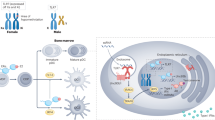Abstract
The interesting observation of male-specific minor histocompatibility was interestingly achieved in rodent transplantation model in 1955, in which isogeneic male skin graft was rejected in the female recipient, but not for other combinations such as female to male, female to female, and male to male (Eichwald and Silmser, Transplant Bull 2:148–149, 1955), implying that gender mismatch plays an important role in graft survival. The underlying mechanism was not unraveled until Dr. Scott et al. identified the mouse male-specific transplantation antigen, H-Y, in 1995 (Scott et al., Nature 376:695–698, 1995). Various H-Y epitopes derived from intracellular proteins can cause genotypically identical graft rejection through their expressions on the cell surface with mouse H-2KK major histocompatibility class I or II (MHC) molecules and subsequent recognitions in an MHC-restricted fashion by host H-Y-specific T lymphocytes, eliciting an anti-H-Y immunoresponse (Scott et al., Nature 376:695–698, 1995). Immunological destruction causes graft rejection or graft-versus-host disease (GVHD) following bone marrow transplantation. Nevertheless, the response to H-Y is in big variation among mice strains dependent largely on quantitative or qualitative differences in H-Y expression of male graft and host’s responsiveness to H-Y.
Access this chapter
Tax calculation will be finalised at checkout
Purchases are for personal use only
Similar content being viewed by others
References
Azuma H, Nadeau K, Mackenzie HS, Brenner BM, Tilney NL. Nephron mass modulates the hemodynamic, cellular, and molecular response of the rat renal allograft. Transplantation. 1997;63(4):519–28.
Csete M. Gender issues in transplantation. Anesth Analg. 2008;107(1):232–8.
Eichwald EJ, Silmser CR. Skin. Transplant Bull. 1955;2:148–9.
Gasbarrini A, Addolorato G, Di Campli C, Simoncini M, Montemagno S, Castagneto M, Padalino C, Pola P, Gasbarrini G. Gender affects reperfusion injury in rat liver. Dig Dis Sci. 2001;46(6):1305–12.
Ge F, Huang T, Yuan S, Zhou Y, Gong W. Gender issues in solid organ donation and transplantation. Ann Transplant. 2013;18:508–14.
Gong W, Thornley T, Whitcher GH, Ge F, Yuan S, Liu DJ, Balasubramanian S. Introduction of modified cervical cardiac transplant model in mice. Exp Clin Transplant. 2012;10(2):158–62.
Gratwohl A, Dohler B, Stern M, Opelz G. H-Y as a minor histocompatibility antigen in kidney transplantation: a retrospective cohort study. Lancet. 2008;372(9632):49–53.
Gu Y, Dirsch O, Dahmen U, Ji Y, He Q, Chi H, Broelsch CE. Impact of donor gender on male rat recipients of small-for-size liver grafts. Liver Transpl. 2005;11(6):669–78.
Harada H, Pavlick KP, Hines IN, Hoffman JM, Bharwani S, Gray L, Wolf RE, Grisham MB. Selected contribution: effects of gender on reduced-size liver ischemia and reperfusion injury. J Appl Physiol (1985). 2001;91(6):2816–22.
He C, Schenk S, Zhang Q, Valujskikh A, Bayer J, Fairchild RL, Heeger PS. Effects of T cell frequency and graft size on transplant outcome in mice. J Immunol. 2004;172(1):240–7.
Hirasawa K, Kamada N. Female sex hormone, estradiol, antagonizes the immunosuppressive activity of cyclosporine in rat organ transplantation. Transplant Proc. 1992;24(1):408–9.
Kasiske BL, Umen AJ. The influence of age, sex, race, and body habitus on kidney weight in humans. Arch Pathol Lab Med. 1986;110(1):55–60.
Muller V, Szabo A, Viklicky O, Gaul I, Portl S, Philipp T, Heemann UW. Sex hormones and gender-related differences: their influence on chronic renal allograft rejection. Kidney Int. 1999;55(5):2011–20.
Muller V, Szabo AJ, Erdely A, Tain YL, Baylis C. Sex differences in response to cyclosporine immunosuppression in experimental kidney transplantation. Clin Exp Pharmacol Physiol. 2008;35(5–6):574–9.
Roopenian DC. What are minor histocompatibility loci? A new look at an old question. Immunol Today. 1992;13(1):7–10.
Scott DM, Ehrmann IE, Ellis PS, Bishop CE, Agulnik AI, Simpson E, Mitchell MJ. Identification of a mouse male-specific transplantation antigen, H-Y. Nature. 1995;376(6542):695–8.
Scott DM, Ehrmann IE, Ellis PS, Chandler PR, Simpson E. Why do some females reject males? The molecular basis for male-specific graft rejection. J Mol Med (Berl). 1997;75(2):103–14.
Soric S, Belanger MP, Askin N, Wittnich C. Impact of female sex hormones on liver tissue lactic acidosis during ischemia. Transplantation. 2007;84(6):763–70.
Spierings E, Vermeulen CJ, Vogt MH, Doerner LE, Falkenburg JH, Mutis T, Goulmy E. Identification of HLA class II-restricted H-Y-specific T-helper epitope evoking CD4+ T-helper cells in H-Y-mismatched transplantation. Lancet. 2003;362(9384):610–5.
Takami H, Backer CL, Crawford SE, Zales VR, Mavroudis C. Influence of gender on allograft rejection in a rat heart transplant model. J Heart Lung Transplant. 1995;14(3):529–36.
Tanaka E. Gender-related differences in pharmacokinetics and their clinical significance. J Clin Pharm Ther. 1999;24(5):339–46.
Vilatoba M, Eckstein C, Bilbao G, Frennete L, Eckhoff DE, Contreras JL. 17beta-estradiol differentially activates mitogen-activated protein-kinases and improves survival following reperfusion injury of reduced-size liver in mice. Transplant Proc. 2005;37(1):399–403.
Wittnich C, Belanger MP, Askin N, Boscarino C, Wallen WJ. Lower liver transplant success in females: gender differences in metabolic response to global ischemia. Transplant Proc. 2004;36(5):1485–8.
Xiao X, Gong W, Demirci G, Liu W, Spoerl S, Chu X, Bishop DK, Turka LA, Li XC. New insights on OX40 in the control of T cell immunity and immune tolerance in vivo. J Immunol. 2012;188(2):892–901.
Zou Y, Steurer W, Klima G, Obrist P, Margreiter R, Brandacher G. Estradiol enhances murine cardiac allograft rejection under cyclosporin and can be antagonized by the antiestrogen tamoxifen. Transplantation. 2002;74(3):354–7, 289–90.
Zukowski M, Kotfis K, Biernawska J, Zegan-Baranska M, Kaczmarczyk M, Ciechanowicz A, Brykczynski M, Ostrowski M, Nikodemski T, Bohatyrewicz R. Donor-recipient gender mismatch affects early graft loss after kidney transplantation. Transplant Proc. 2011;43(8):2914–6.
Author information
Authors and Affiliations
Editor information
Editors and Affiliations
Rights and permissions
Copyright information
© 2022 The Author(s), under exclusive license to Springer Nature Singapore Pte Ltd.
About this chapter
Cite this chapter
Gong, W. (2022). Role of Gender in Animal Transplantation. In: Gong, W. (eds) Rodent Transplant Medicine. Springer, Singapore. https://doi.org/10.1007/978-981-19-6111-3_4
Download citation
DOI: https://doi.org/10.1007/978-981-19-6111-3_4
Published:
Publisher Name: Springer, Singapore
Print ISBN: 978-981-19-6110-6
Online ISBN: 978-981-19-6111-3
eBook Packages: MedicineMedicine (R0)




